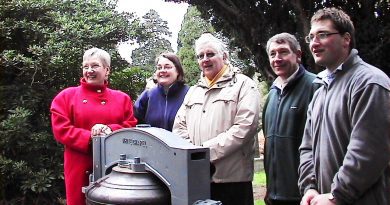Bellringers – Techniques and Learning
What is bellringing?
When a bell is rung it rotates through a complete circle; it then rests on the balance, mouth upwards. The ringer can vary to some extent the time during which the bell is held on balance. This slight variation enables a change in the order in which the bells sound each time they are rung, but it is only practicable for a bell to change places with its immediate neighbour – a bell cannot “jump” two or more places, so tunes are not possible on bells hung for full circle ringing.
How does this work in practice? The bells begin by ringing a downward scale, i.e. they strike in order from the lightest to heaviest. This sequence is known as rounds and on eight bells would be written as 12345678. From this point, one of the ringers (the conductor) can call out the numbers of the bells which are to change position to obtain a new sequence – e.g. by calling “three to four” the sequence 12435678 is produced, and so on. This is known as call changes and is very useful for introducing learners to the bell control they will need to ring changes accurately.
If you are listening to the bells you will recognise call changes easily, as the bells strike in almost the same sequence, with only slight variation in order, for some time. This is because the conductor allows the bells to settle down in their new sequence before calling another change.
Call changes give the learner the opportunity to listen to their own bell striking after another for several blows, and to realise that they must leave a larger gap when following a heavier bell as the latter has a larger wheel and so turns more slowly.
A more experienced band will progress from call changes to change ringing, where the sequence of the bells alters at every stroke according to a predetermined pattern learned by all the ringers.
The patterns, known as methods, vary a great deal in complexity.
If when you listen to the bells you notice that they strike in a different order every time they sound, this means that a method, rather than call changes, is being rung.
Peal: The ultimate ringing performance is a peal which entails approximately three hours continuous ringing and is undertaken on special occasions
Quarter peal: As its name implies this is one quarter of a peal and takes approximately 50 minutes. This is normally for special services.
Half muffled: This is to create a special effect where alternate strokes appear to be an echo and is used for funeral and in memoriam ringing.
Learning to Ring
The first skill a ringer has to master is known as bell handling. This means the ringer must be able to control the swing of the bell so that it rings with the correct rhythm. The first steps in learning bell control are always done under individual tuition with constant supervision by an experienced ringer to avoid any mishaps.
The next stage involves ringing a bell to rounds (the downward scale sequence) with other members of the band. This always generates a sense of achievement in the learner, akin to joining a team in sport. He (or she) must not only be secure in the technique of rope handling, but also be able to control the bell so that it rings at the correct rhythm in time with the rest of the band.
Most people pick up the basics of bell control after about half a dozen individual coaching sessions. As with most skills, youngsters seem to learn faster!
Most ringers find call changes of limited interest and progress to method ringing. This involves the bells striking in a different order at every stroke according to a predetermined pattern.


